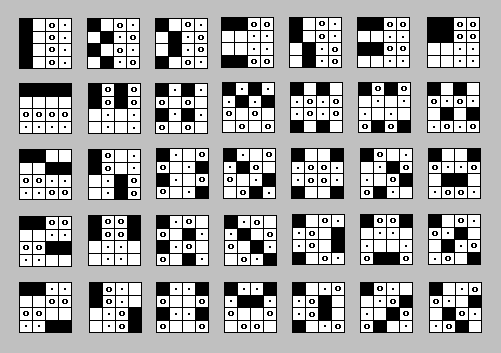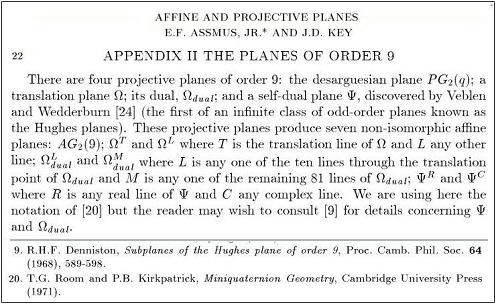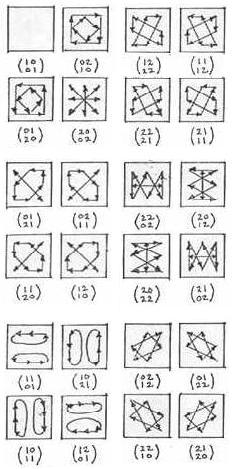Analogical
Train of Thought
Part I: The 24-Cell
From S. H. Cullinane,
Visualizing GL(2,p),
March 26, 1985–
From John Baez,
“This Week’s Finds in
Mathematical Physics (Week 198),”
September 6, 2003:
Noam Elkies writes to John Baez:
Hello again,
You write:
[…]
“I’d like to wrap up with a few small comments about last Week. There I said a bit about a 24-element group called the ‘binary tetrahedral group’, a 24-element group called SL(2,Z/3), and the vertices of a regular polytope in 4 dimensions called the ’24-cell’. The most important fact is that these are all the same thing! And I’ve learned a bit more about this thing from here:”
[…]
Here’s yet another way to see this: the 24-cell is the subgroup of the unit quaternions (a.k.a. SU(2)) consisting of the elements of norm 1 in the Hurwitz quaternions – the ring of quaternions obtained from the Z-span of {1,i,j,k} by plugging up the holes at (1+i+j+k)/2 and its <1,i,j,k> translates. Call this ring A. Then this group maps injectively to A/3A, because for any g,g’ in the group |g-g’| is at most 2 so g-g’ is not in 3A unless g=g’. But for any odd prime p the (Z/pZ)-algebra A/pA is isomorphic with the algebra of 2*2 matrices with entries in Z/pZ, with the quaternion norm identified with the determinant. So our 24-element group injects into SL2(Z/3Z) – which is barely large enough to accommodate it. So the injection must be an isomorphism.
Continuing a bit longer in this vein: this 24-element group then injects into SL2(Z/pZ) for any odd prime p, but this injection is not an isomorphism once p>3. For instance, when p=5 the image has index 5 – which, however, does give us a map from SL2(Z/5Z) to the symmetric group of order 5, using the action of SL2(Z/5Z) by conjugation on the 5 conjugates of the 24-element group. This turns out to be one way to see the isomorphism of PSL2(Z/5Z) with the alternating group A5.
Likewise the octahedral and icosahedral groups S4 and A5 can be found in PSL2(Z/7Z) and PSL2(Z/11Z), which gives the permutation representations of those two groups on 7 and 11 letters respectively; and A5 is also an index-6 subgroup of PSL2(F9), which yields the identification of that group with A6.
NDE
The enrapturing discoveries of our field systematically conceal, like footprints erased in the sand, the analogical train of thought that is the authentic life of mathematics – Gian-Carlo Rota |
Like footprints erased in the sand….
Log24, May 27, 2004 —
“Hello! Kinch here. Put me on to Edenville. Aleph, alpha: nought, nought, one.”
“A very short space of time through very short times of space….
Am I walking into eternity along Sandymount strand?”
— James Joyce, Ulysses, Proteus chapter
A very short space of time through very short times of space….
“It is demonstrated that space-time should possess a discrete structure on Planck scales.”
— Peter Szekeres, abstract of Discrete Space-Time
“A theory…. predicts that space and time are indeed made of discrete pieces.”
— Lee Smolin in Atoms of Space and Time (pdf), Scientific American, Jan. 2004
“… a fundamental discreteness of spacetime seems to be a prediction of the theory….”
— Thomas Thiemann, abstract of Introduction to Modern Canonical Quantum General Relativity
“Theories of discrete space-time structure are being studied from a variety of perspectives.”
— Quantum Gravity and the Foundations of Quantum Mechanics at Imperial College, London
Disclaimer:
The above speculations by physicists
are offered as curiosities.
I have no idea whether
any of them are correct.
Related material:
Stephen Wolfram offers a brief
History of Discrete Space.
For a discussion of space as discrete
by a non-physicist, see John Bigelow‘s
Space and Timaeus.
Part III: Quaternions
in a Discrete Space













